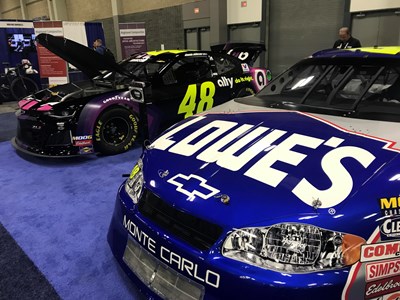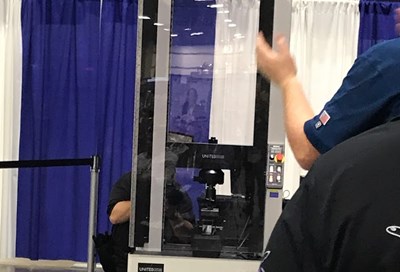SAMPE 2019: The highlights
CompositesWorld was at SAMPE 2019 and offers a summary of highlights from the show and conference.

CW photo | Scott Francis
SAMPE 2019 was held in Charlotte, N.C., U.S., which represented the event’s first foray to that city. CompositesWorld was there and offers this summary of highlights from the show and conference.

Greg Hyslop, CTO of Boeing, giving the keynote presentation at SAMPE 2019. CW photo | Scott Francis
Boeing keynote. SAMPE kicked off with a keynote from Dr. Greg Hyslop, chief technology officer for the Boeing Co. (Chicago, Ill., U.S.). His presentation focused on the future of advanced materials and highlighted the importance of collaboration and the willingness to share information and ideas. He touched on some of Boeing’s programs starting with the 777X, which features the largest carbon fiber wing ever made. The aircraft will begin flight testing later this year. Once in service, the 777X will, said Hyslop, enable continuous flight between any two points on Earth. Hyslop touted the success of the composites-intensive 787 Dreamliner, which he says has saved more than 20 billion pounds of fuel since its introduction and is shaping the thinking of the company as it moves forward.
Boeing’s programs beyond commercial aircraft include the Echo Voyager autonomous submersible, the T-X U.S. Air Force trainer, the MQ-25 unmanned tanker (which will reportedly have its first flight at the end of the summer) and the XS-P Phantom Express reusable spaceplane, designed for the Defense Advanced Research Projects Agency (DARPA, Arlington County, Va., U.S.), which features a composite cryotank designed to reduce tank weight by 40%.
Hyslop discussed ways in which Boeing is working to address the growing problem of ground-based traffic and congestion, and an increasingly crowded airspace. He discussed the Boeing NeXt program, which is aimed at urban, regional and global mobility. In addition, in 2017 Boeing acquired Aurora Flight Sciences (Manassas, Va., U.S.), which has been working on an air taxi program. Meanwhile Boeing is partnering with Aerion (Reno, Nev., U.S.) on supersonic travel.
During a Q&A session after the talk, when asked about the future of aluminum use in fuselage structures, Hyslop admitted that aluminum still has a significant role to play in aircraft fuselages, but reiterated the significant role that composites play — and will continue to play. He described the company’s approach to materials as “holistic.”

Two NASCAR vehicles displayed side-by-side showed the evolution of carbon fiber composites between 2002 and now. CW photo | Hannah Mason
NASCAR’s composites evolution. Jeff Andrews, director of engine operations at Hendrick Motorsports (Charlotte, N.C., U.S.), gave a presentation on the evolution of composites in NASCAR. Currently the sport puts an emphasis on composites use for components mounted higher in the vehicle, aiming for weight savings and achieving a lower center of gravity. Composites are used in such components as gear cooler ducting, brake ducts, battery cases and components high on the engine. Current body components include the front fascia, hood, rear deck lid and rear fascia, but Andrews expects that “implementation of all-composite bodies is in the very near future” for NASCAR, indicating that it could happen within 2-4 years. As proposed, a full composite body system would provide for a more consistent surface over the length of the vehicle with the desire of streamlining vehicle build times.

CW photo | Scott Francis
On display on the SAMPE show floor were two NASCAR racecars. Both were built by Hendricks Racing for Jimmie Johnson: his 2019 car (purple) next to his 2002 car (his first). The 2019 car has 35% more carbon fiber on it than the 2002 car, which had a few carbon ducts but was almost entirely metal. The 2019 car has a carbon fiber hood, part of the nose, trunk, seat, bumpers and some small parts. The largest carbon fiber part is the seat.
Solvay elevates thermoplastics: Solvay Composites Materials (Alpharetta, Ga., U.S.) introduced at SAMPE Fabrizio Ponte, recently named head of the company’s thermoplastic composites platform. Further, Ponte said, elevation of Solvay’s thermoplastic incubator to a Solvay Group Growth Platform should send a strong signal to the market about how important thermoplastics growth is to the company. He pointed out that Solvay has a long history of thermoplastics development, and is no stranger to the polyketones that dominate the aerospace market. “If it starts with a ‘p’ and ends with a ‘k,’” he quipped, “we make it. We want the market to understand how serious we are about the thermoplastics market and that we are serious about developing products for this space.” To that end, Ponte said Solvay is working on expanding its thermoplastics capacity, will soon open a thermoplastics prepreg lab, and is accelerating several new thermoplastics chemistries. Ponte also noted that Solvay is targeting its thermoplastics toward automotive and oil and gas applications as well.
Huntsman adhesive launch. The most prominent product announcement at SAMPE was made by Huntsman Advanced Materials (The Woodlands, Texas, U.S.), which introduced four products. Epocast 1649-1 FST A/B is an Airbus-qualified adhesive and void filler — a low-density, fast-cure paste that can be mixed and applied manually with a 2:1 mix ratio or used in a dual-barrel cartridge with static mixer. It’s designed for insert potting, ditch potting, edge filling and honeycomb reinforcement. Epocast 1648 A/B is a Boeing-qualified (BMS 5-28, Type 18, Class 1) adhesive and void filler. It is a low-density, flame-retardant, thixotropic compound designed for use with honeycomb structures. It can be dispensed via meter mix or cartridge and sets quickly at room temperature. Applications include ditch and pot forming, core reinforcement and edge filling/sealing.
New to the Araldite acrylate adhesive line are Araldite 2050 and Araldite 2051, and both are designed for use in “extreme” conditions. The 2050 product (designed for “cold and wet”) is said to be ultrafast-curing from -20°C to 25°C without additional heat and can be applied under water or in humid areas. It requires no surface preparation and provides what is said to be outstanding adhesion on dissimilar substrates. It’s temperature-resistant up to 120°C. Araldite 2051 (designed for “warm and humid”) is fast-curing from 0°C to 40°C, also can be applied under water and also is temperature-resistant up to 120°C. Both products are targeted toward wind blade and marine repair applications.

CW photo | Scott Francis
Web in Seattle. Web Industries (Marlborough, Mass., U.S.) announced at SAMPE that it is building a new facility in Marysville, Wash., U.S. (near Seattle), that will provide tape slitting and winding services, as well as ply cutting and kitting, off-angle/off-axis tape production, and research and development services. The new facility will supply slit tape for the Boeing 777X and position the company to provide responsive formatting services to other businesses in the region, Web officials said. Web will break ground on the 85,000-square-foot plant in 2019 and plans to begin operations in 2021.

CW photo | Hannah Mason
Building, breaking bridges. Finally, SAMPE featured, as usual, the student bridge-building competition. Each bridge entered, conforming to established material and design criteria in several categories, was stressed to failure. The overall contest winners were, in order, Chengdu Aeronautic Polytechnic (Chengdu, China), University of Washington (Seattle) and Centro Universitário da FEI (São Bernardo do Campo, Brazil).
Related Content
ECOHYDRO project to enable recyclable composites for hydrogen storage
With the involvement of two schools from the Institut Mines-Télécom, the 4-year project aims to improve the intrinsic properties of a composite material based on Elium via four concrete demonstrators.
Read MoreNovel composite technology replaces welded joints in tubular structures
The Tree Composites TC-joint replaces traditional welding in jacket foundations for offshore wind turbine generator applications, advancing the world’s quest for fast, sustainable energy deployment.
Read MoreComposites end markets: Energy (2024)
Composites are used widely in oil/gas, wind and other renewable energy applications. Despite market challenges, growth potential and innovation for composites continue.
Read MoreHonda begins production of 2025 CR-V e:FCEV with Type 4 hydrogen tanks in U.S.
Model includes new technologies produced at Performance Manufacturing Center (PMC) in Marysville, Ohio, which is part of Honda hydrogen business strategy that includes Class 8 trucks.
Read MoreRead Next
Boeing CTO addresses advanced materials in aerospace, urban mobility
Boeing CTO Dr. Greg Hyslop, in SAMPE keynote, discusses the company’s aircraft programs and the role composites will play in the future of aerial infrastructure.
Read More“Structured air” TPS safeguards composite structures
Powered by an 85% air/15% pure polyimide aerogel, Blueshift’s novel material system protects structures during transient thermal events from -200°C to beyond 2400°C for rockets, battery boxes and more.
Read MoreVIDEO: High-volume processing for fiberglass components
Cannon Ergos, a company specializing in high-ton presses and equipment for composites fabrication and plastics processing, displayed automotive and industrial components at CAMX 2024.
Read More
.jpg;width=70;height=70;mode=crop)






















